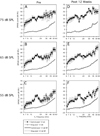Noise-induced hearing loss in mice treated with antiretroviral drugs
- PMID: 18384985
- PMCID: PMC2441919
- DOI: 10.1016/j.heares.2008.01.016
Noise-induced hearing loss in mice treated with antiretroviral drugs
Abstract
The results reported here for CBA/CaJ mice describe the effects of regular dosing with a common antiretroviral drug combination on outer hair cell (OHC) function using measures of 2f1-f2 distortion product otoacoustic emissions (DPOAEs) and auditory brainstem responses (ABRs). Specifically, experimental mice were treated daily over a 3-mo period with the nucleoside reverse transcriptase inhibitors (NRTIs), zidovudine (ZDV) and lamivudine (3TC), dissolved in their drinking water, while their control counterparts received untreated water. DPOAE levels and ABR detection thresholds prior to and after 12 wk of NRTI treatment did not differ between experimental and control groups. To assess whether NRTI treatment potentiates the adverse effects of noise over-exposure on OHC function, both experimental and control mice were exposed 1 wk later, while still on the drug regimen, to a 10-kHz octave-band noise (OBN) at 105-dB SPL for 1h. A major outcome of the sound over-exposure episode was that the NRTI-pretreated mice showed significantly greater permanent OBN-induced reductions in DPOAE levels at 2 wk postexposure than were observed for the untreated control animals. These findings support the notion that a synergistic relationship exists between certain NRTIs and intense sounds in that such preexposure drug treatments produced greater noise-induced decreases in DPOAE activity than did noise exposure alone. This drug/noise interaction is consistent with the known harmful effects of NRTIs on cellular mitochondrial activity.
Figures



Similar articles
-
Temporary and permanent noise-induced changes in distortion product otoacoustic emissions in CBA/CaJ mice.Hear Res. 2001 Jun;156(1-2):31-43. doi: 10.1016/s0378-5955(01)00265-9. Hear Res. 2001. PMID: 11377880
-
Effect of infrasound on cochlear damage from exposure to a 4 kHz octave band of noise.Hear Res. 2007 Mar;225(1-2):128-38. doi: 10.1016/j.heares.2007.01.016. Epub 2007 Jan 19. Hear Res. 2007. PMID: 17300889 Free PMC article.
-
DPOAE level shifts and ABR threshold shifts compared to detailed analysis of histopathological damage from noise.Hear Res. 2002 Dec;174(1-2):158-71. doi: 10.1016/s0378-5955(02)00653-6. Hear Res. 2002. PMID: 12433407
-
Antioxidant treatment reduces blast-induced cochlear damage and hearing loss.Hear Res. 2012 Mar;285(1-2):29-39. doi: 10.1016/j.heares.2012.01.013. Epub 2012 Feb 6. Hear Res. 2012. PMID: 22326291
-
Paired measurements of cochlear function and hair cell count in Dutch-belted rabbits with noise-induced hearing loss.Hear Res. 2020 Jan;385:107845. doi: 10.1016/j.heares.2019.107845. Epub 2019 Nov 15. Hear Res. 2020. PMID: 31760262 Free PMC article.
Cited by
-
Hearing Loss in Offspring Exposed to Antiretrovirals During Pregnancy and Breastfeeding.Front Mol Neurosci. 2022 Jun 20;15:920528. doi: 10.3389/fnmol.2022.920528. eCollection 2022. Front Mol Neurosci. 2022. PMID: 35795690 Free PMC article.
-
Auditory Impairments in HIV-Infected Children.Ear Hear. 2016 Jul-Aug;37(4):443-51. doi: 10.1097/AUD.0000000000000276. Ear Hear. 2016. PMID: 26881980 Free PMC article.
-
Main Aspects of Peripheral and Central Hearing System Involvement in Unexplained HIV-Related Hearing Complaints.Front Neurol. 2019 Aug 6;10:845. doi: 10.3389/fneur.2019.00845. eCollection 2019. Front Neurol. 2019. PMID: 31447765 Free PMC article. Review.
-
Neurological and psychiatric adverse effects of antiretroviral drugs.CNS Drugs. 2014 Feb;28(2):131-45. doi: 10.1007/s40263-013-0132-4. CNS Drugs. 2014. PMID: 24362768 Review.
-
In vitro assessment of antiretroviral drugs demonstrates potential for ototoxicity.Hear Res. 2014 Apr;310:27-35. doi: 10.1016/j.heares.2014.01.005. Epub 2014 Jan 31. Hear Res. 2014. PMID: 24487230 Free PMC article.
References
-
- AVERT. 2007. http://www.avert.org/worldstats.htm (last viewed 10/30/07)
-
- Ayers KM, Torrey CE, Reynolds DJ. A transplacental carcinogenicity bioassay in CD-1 mice with zidovudine. Fundam Appl Toxicol. 1997;38:195–198. - PubMed
-
- Barregard L, Axelsson A. Is there an ototraumatic interaction between noise and solvents? Scand Audiol. 1984;13:151–155. - PubMed
-
- Billett TE, Thorne PR, Gavin JB. The nature and progression of injury in the organ of Corti during ischemia. Hear Res. 1989;41:189–197. - PubMed
-
- Birchall MA, Wight RG, French PD, Cockbain Z, Smith SJ. Auditory function in patients infected with the human immunodeficiency virus. Clin Otolaryngol Allied Sci. 1992;17:117–121. - PubMed
Publication types
MeSH terms
Substances
Grants and funding
LinkOut - more resources
Full Text Sources
Miscellaneous

